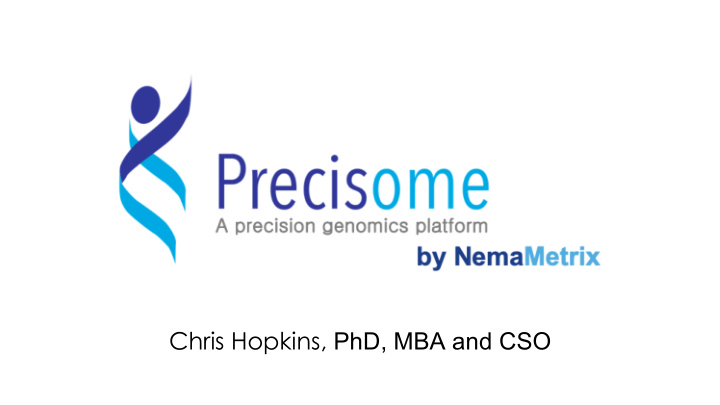



Chris Hopkins, PhD, MBA and CSO
patient variant drug p.R292H pathogenicity
Is this variant in my patient pathogenic or benign? "The Doctor" by Sir Luke Fildes (1891)
Drop in genome price drives increase in patient variant observations ClinVar variant observations Moore's law clinical testing submissions literature only Cost per research genome curation other ● Since 2016, clinical testing up more than 6x
Observed variants are small fraction of theoretical 0.15% benign 0.27% path 80,000,000 possible dark matter https://clinvarminer.genetics.utah.edu
Observed variants are in 3 major classes Benign Pathogenic 36% 19% 42% n.d. VUS Variants of Uncertain Significance https://clinvarminer.genetics.utah.edu
Observed variants in established genes still have VUS problem Well studied genes
Hot spots and cold spots in STXBP1 (benign) ● STXBP1 gene has regions where pathogenicity is likely highMAF: TOPMED, GnomAD, ExAC, GO-ESP, 1000G
Installing genetic variation in small animals creates a diagnostic tool for VUS functional studies Nematode ( C. elegans ) Zebrafish ( D. rerio ) ● Understand disease mechanism ● Personalized therapeutics
Discovery platform occurs in three phases Phase I - Humanize: Gene-Swap Technique Clinical Phase II - Variant Install: measure functional defects Avatar Phase III - Best-Fit: screen existing AEDs ● Personalized proxy of patient
Humanize: Geneswap of STXBP1 rescues function nematode Gene ( unc-18 ) Electrophysiology (Hz) nd human * * 4 Gene (STXBP1) 2 0 human WT KO gene Phase I
Clinical Avatars are Variant install: tested for pathogenicity p.Arg406His Benign ? R406H KO human gene Humanized Pathogenic ? R406H KO human gene Phase II
Functional testing demonstrated on two systems Electrophysiology Movement n n x x C C H H a 2 a 2 5 6 5 6 m e 2 m e 2 7 7 0 0 1 1 n n u Y u Y 4 4 R R e e h R h R g g ● R122x deviant in electrophysiology, Y75C deviant in movement ● Pathogenic R406H variant showing minimal deviation from normal
R406H has phenotype by eye hSTXBP1-R406H hSTXBP1- Knock Out hSTXBP1-wt ● Need multiple parameter testing
PCA plot detects subtle differences human gene MBF Y75C R406H R122x P C 3 4 10 3 8 2 6 1 4 morphology PC2 0 movement PC1 2 -1 0 -2 -2 -3 -4 ● Variants are in distinct and non-overlapping clusters
PCA plot of ephys also separates variants PC3 human gene Y75C R406H R122x i P n C t e 2 n s PC1 i t y Frequency ● Each variant in different clusters
Drug screening on Best-Fit: STXBP1 Clinical Avatars Restore wild type Benign behavior EC50 Pathogenic ● Formats up to 1536 well ● Multiparameter measurements Phase III
Clinical Avatars validate AI generated hits Clinical Variants modeled in STXBP1 activity hits Clinical Avatar Chemical rescue p.R406H ● Hits giving rescue move forward in drug development pipeline
Targeting 100 variants for Clinical Avatar creation ● 55 identified (24 ready), 45 more to go
Precisome targets: Genes correlated with seizures and neurological other targets Epilepsy Neurodegen Ataxia STXBP1 MAPT ATP1A3 AAP KCNQ2 SCN1A PSEN1 CDKL5 CACNA1A SLC2A1 TARDBP SNC2A GRN POLG MTHFR C9orf72 NALCN LMNA
Acknowledgments STXBP1 Foundation Anne Johnson Charlene Son Rigby CHOP Ingo Helbig Katherine Helbig Harvard Heidi Rehm Phil Pearl Rady Matthew Bainbridge Phoenix Michael Kruer King Faisal Fowzan Alkuraya Mayo Tom Caulfield Dave Freedman William Tatum Tel Aviv Miguel Weil Lior Dor
patient variant drug p.R292H pathogenicity
Recommend
More recommend